Grindstone for a 17th century olive oil mill, a thousand-year old olive tree
Though some time was alloted in Puglia for activities not requiring mastication, the bulk of the trip was spent at food production sites, restaurants and agricultural lands. I realize that this must sound like the best foodie vacation ever, but eating rich foods nonstop for a week is not as pleasant as it may seem. Some of us had the added stress of documenting the trip in detail because there is a paper and presentation required after the stage. By the end, we were all thoroughly sick of cured meats, cheeses and each other. A few people actually became ill, though I cannot say whether this was due to food poisoning, general infection, or the stress of traveling and eating from 9 am to 1 am every day. My advice for anyone who goes on these trips is to ingest plenty of fiber and choose your roommate carefully.
Moving on to the actual food. Puglia’s dry, sunny climate makes it difficult to grow many crops, but the hardiness of olive trees in times of drought has resulted in their widespread cultivation. The trees dot the Puglian landscape with their graceful, twisted trunks and branches, akin to a pair of ballet dancers. We were told by one farmer that the trees twist according to the Earth’s rotation, and that olive trees planted south of the equator would twist in the opposite direction, similar to the rotation of water draining from toilets. This is a romantic idea, but since the Coriolis force has been shown to have a tenuous effect on toilet water, I am somewhat doubtful of the tree-twisting claim.
Still, the trees are majestic to behold, knotted and gnarly, reminiscent of the baobab tree in The Little Prince. The one pictured above actually belongs to a Russian who admired the unique shape of its trunk. So, he bought the tree for €5,000. In return, he gets to keep the olive oil milled from the olives of this tree, which comes to 10-15 liters of oil per year. He also comes to visit his tree annually. If you are interested in owning a piece of Italian real estate and having a lifetime supply of olive oil, you too can invest in one of the 50,000 available trees for the low price of €500-1,000 by contacting Olio Cazzetta.
We also had the chance to visit two 17th century old olive oil mills and a modern processing plant. The olive harvest occurs in the fall, from approximately October through January. Before the era of mechanization, olives were picked by women in the fields, then pressed by men working in underground olive oil mills. These mills would employ 20-25 people (depending on the size of the mill), and the employees would live inside the mill for the duration of the harvest, along with work animals like donkeys. The grindstone was used to crush the olives, then the olive paste was placed in tiers of woven mats and pressed to extract the oil. At the end of the harvest, the donkeys would be killed (and presumably eaten).
To taste olive oil, you should first examine the color (yellow, green tones?), then the aroma (grassy, tomato leaf, artichoke?), and finally sip the olive oil while sucking in air and exhaling from your nose. A high quality olive oil should not feel greasy in the mouth, should have flavors that match the aroma, and should be peppery with the presence of polyphenols. We tasted olive oils from Torre Guaceto and Olio Cazzetta, and my favorite was the Cazzetta Spontaneo, produced from the prime layer of oil floating at the top of the crushed olives.
Clockwise: hanging salame and prosciutto, seasoning a capocollo, finished product with a sprig of thyme, wrapping capocollo in natural casing
Next up, we trekked to the butcher shop of Romanelli Tommaso to investigate capocollo production in Martina Franca. The south of Italy is not well known for its cured meats because the weather is generally too hot. However, as a peninsula, Puglia is buffeted by strong sea winds, and so it is possible to produce some cured meats. Capocollo is a portmanteau of capo (head) and collo (neck), since that is the part of the pig that is used for this product.
In a nutshell, you take pork shoulder and remove any large veins or blood, then season it with salt, pepper and a wine bath (preferably a white bianco Martina). Then, tenderize it with a spiky dowel, wrap it in a natural casing and a layer of cloth, then leave it for 10-12 days, depending on the outside temperature. Once the aging period is over, you season and smoke the capocollo using a mixture of Fania wood and almond skins. Each capocollo lot is packaged and stamped with a serial number, so that you can trace the origin of the pork and intermediate handlers.
We watched as the team of three butchers deftly seasoned, wrapped and tied several dozen capocollo. Two of the butchers had been childhood friends and have worked in the business since ages 7 and 12.
Clockwise: Alberello pugliese (small tree) vine-growing technique, guided-vine technique, selection of Candido wines, Candido’s wine analysis laboratory
We had several dinners with local wine producers, where we got to chat with vineyard owners, and had the opportunity to see the vineyard for Candido under the blazing hot Puglia sun. This is a land of negroamaro and primitivo grape varietals, commonly used to make robust red wines. However, rising demand for white wines led producers to begin planting international varietals like chardonnay in the 1980s. The Puglia region is still not known for its white wines (in fact, in class we were told by a professor to never order whites in Puglia), but we actually sampled several excellent whites over the course of the week. So, maybe the region’s reputation for whites will improve in the next few years.
Above you see two techniques for growing grape vines, the guided vine technique, where the vine is strung along a wire, and the alberello pugliese technique, or “little tree,” where the vines are tied together like a small tree. The guided vine practice is easier for pruning and maintenance, and the alberello technique requires more attention and skill at harvest time. However, the quality of the harvested grapes is higher, with well-separated grapes and less dense grape stems, so Candido continues using the traditional alberello growing technique for some varietals, like the aleatico.
We were able to sample four of Candido’s wines (red, white, rosé and dessert), paired with fresh cheeses, salame, seafood pasta and almond paste cookies. Ironically, despite the trumpeting of the Cappello di Prete red with “big personality,” my favorites of the bunch were the white (Tenuta Marini, fiano minutolo) and rosé (Le Pozzelle, negroamaro & malvasia nera) wines, which were wonderfully floral, fruity and refreshing, perfect for a hot summer day. I ended up buying a bottle of Le Pozzelle to take home with me; at €4,50 it was a steal.
Clockwise: fresh mozzarella, prosciutto and seafood pasta; the making of fresh mozzarella; cheese, artichokes and Puglia’s famed cherry tomatoes; tray of mozzarella balls
Cheese! From “Cheese” Whiz to Roquefort, there are many different styles of curdled milk, and we sampled many in Puglia. So many, that most of us had sworn off cheese by the end of the week. Fresh cheeses made with raw milk are very much in vogue here, and I ate an immense amount of mozzarella (made with buffalo milk), fior di latte (the same cheese made with cow’s milk), and ricotta. During the mozzarella making demonstration, our entire class went beserk, trying to photograph every motion of the cheesemaker. I wasn’t close enough to get too many good shots, but there is some very sexy cheese porn floating around.
The only downside is I may never be able to eat mozzarella again in the U.S. In particular, the burrata cheese was religiously good. Burrata is a ball of mozzarella filled with stracciatella and cream in the center. When you slice it open, the cream oozes out, and you taste an explosion of sweet, creamy goodness. We were pretty much rolling on the ground in ecstasy.
Clockwise: octopus, pasta with langoustine, maritare (marriage) pasta combining two different shapes (cavatelli and orecchiette), braised ass/donkey
Finally, Puglia’s coastal location lends itself to an abundance of seafood in the local diet. Octopus was on every menu, along with mussels, clams and squid. I tried langoustine for the first time and successfully dug some meat out of the tiny claws. In case you aren’t a seafood fan, we also tried a number of meats: tripe, donkey and horse. The latter two taste an awful lot like beef, especially when covered with ragu sauce.
Time to detox in advance of our next stage in the Piemonte region in 2 weeks.



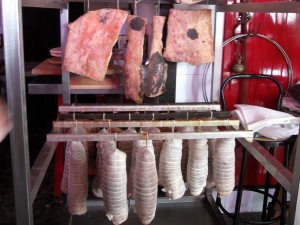






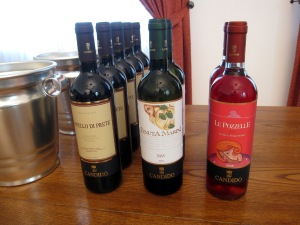




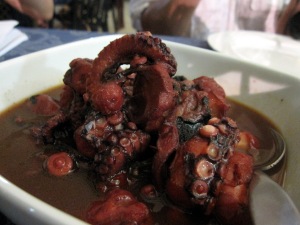
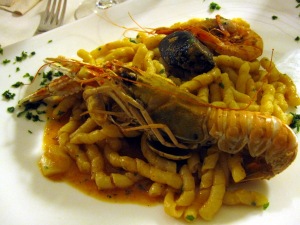
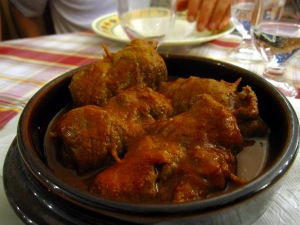

My what a fine ass that looks to be!
All I want to do now is get a piece of ass.